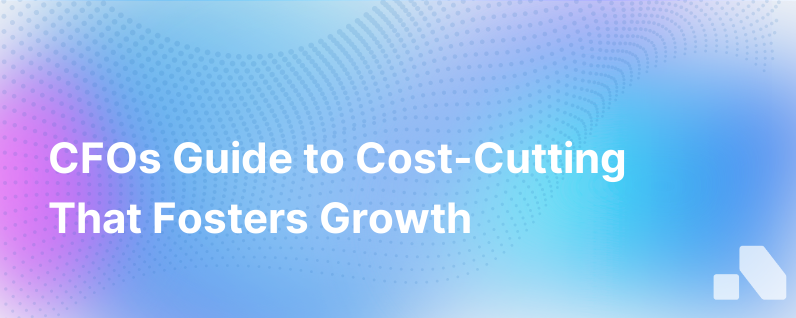How Cfos Can Trim Budgets Without Hindering Growth
Published on October 17, 2023 by David Zhang
In the ever-evolving landscape of business, the role of a Chief Financial Officer (CFO) stretches far beyond the traditional boundaries of balancing budgets and overseeing accounts. Today’s CFOs play a pivotal role in strategic decision-making, especially when it comes to nurturing growth amidst the pressing need to trim budgets. Effective financial stewardship requires a delicate balancing act, ensuring that cost-cutting measures do not stifle the potential for expansion and progress.
Engaging in a strategic budgetary cutback without compromising growth demands a multi-pronged approach. It entails an in-depth understanding of the company's operations, the agility to respond to a dynamic market environment, and the wisdom to invest in areas that promise sustainable growth.
Strategic Cost Optimization
Strategic cost optimization is the cornerstone of trimming budgets while fostering growth. Unlike mere cost-cutting, which may indiscriminately reduce spending, strategic cost optimization involves a thorough analysis of expenditures to discern which costs can be trimmed without sacrificing essential business functions. This strategy might entail a comprehensive audit of all operations, seeking inefficiencies, redundancies, or areas where technology can automate processes, thereby reducing staffing costs.
Investment in Technology
Investing in technology holds the key to cost optimization that aligns with long-term growth. Automation and advanced data analytics can streamline operations, reduce manual errors, and provide insights that facilitate better strategic decisions. For instance, a transition to cloud computing not only cuts down on the costs associated with maintaining on-premises IT infrastructure but also enhances scalability and flexibility essential for growth.
Outsourcing Versus In-Housing
A CFO must examine the return on investment (ROI) of outsourcing versus maintaining certain functions in-house. While outsourcing can reduce immediate operational costs, it's crucial to consider the long-term implications on quality control, intellectual property security, and the potential for scaling operations. Decisions here need to proceed from a strategic understanding of which capabilities are core to the company's value proposition and competitive advantage.
Lean Operations
Trimming budgets without stifling growth means doing more with less—implementing lean principles across the organization encourages efficiency and minimizes waste. A lean approach scrutinizes every process to ensure that it adds value from the customer's perspective. This relentless focus on value can drive down costs while enhancing the company’s offerings.
Focus on High-Margin Products and Services
Prioritizing high-margin offerings can be an effective way for CFOs to swing the budgetary scalpel. By evaluating the profitability of each product or service, CFOs can make informed decisions about where to allocate resources most effectively, diverting capital and operational effort away from low-margin offerings and toward those that promise greater returns.
Data-Driven Decision Making
Data serves as the lifeblood of informed budgetary decisions. A CFO must advocate for data-driven decision-making, championing the use of advanced analytics to understand the financial implications of every part of the business. By thoroughly analyzing data, CFOs can pinpoint exact areas of overspending, identify unnoticed revenue streams, or validate the potential effectiveness of cost-cutting measures.
Agile Budgeting
Rigid budgeting can be the enemy of innovation and growth. Embracing a more flexible approach to budgeting—often referred to as agile budgeting—allows a company to quickly adapt to market changes or pivot towards more lucrative opportunities. This practice often involves setting aside a portion of the budget for unanticipated opportunities or challenges, enabling the company to respond without delay.
Cross-Departmental Collaboration
Silos are detrimental to efficient budgeting. Fostering cross-departmental collaboration can unearth insights on where costs can be reduced without undermining growth. For example, input from the sales and marketing teams might reveal under-utilized initiatives, while discussions with product development may highlight opportunities to streamline features without impacting customer satisfaction.
Maintaining Customer Focus
Trimming budgets should not come at the expense of customer satisfaction or market position. A customer-centric approach ensures that decisions made to optimize the budget do continually contribute to a positive customer experience and sustained demand, which, in turn, supports growth.
Leadership in Cost Management Culture
The tone set by leadership profoundly impacts the entire organization's approach to cost management. A CFO must champion a culture where prudent spending is valued and everyone is encouraged to be cost-conscious. Empowering employees to contribute cost-saving ideas fosters an environment where efficiency is a shared goal, not merely a top-down directive.
Reinforcing Employee Morale and Engagement
Cost reductions often raise fears of job security, which can harm morale and productivity. Transparent communication about the reasons for budget cuts and the company's growth strategy can alleviate such concerns. Additionally, involving employees in the problem-solving process can lead to innovative cost-saving measures while boosting engagement and morale.
Evaluating Risk and Opportunity Costs
With every budgetary reduction, a CFO must weigh the risks and opportunity costs involved. This involves a forward-looking analysis—not just immediate savings, but the implications on future revenue and company positioning. What might be saved today could be lost tomorrow if a cut compromises the company’s ability to compete or respond to market demands.
Leveraging Industry Benchmarks
Industry benchmarks provide valuable insights into how a company's spending measures up against its peers. Comparison against these benchmarks offers a reality check: if competitors are spending less and still thriving, opportunities likely exist to recalibrate expenditures accordingly.
Measuring Outcomes and Adjusting
Decisions to trim budgets are seldom perfect on the first attempt. Therefore, it’s crucial to measure the outcomes of every cost-cutting action and remain ready to adjust strategies as necessary. Monitoring key performance indicators (KPIs) that align with budgetary measures and overall company health ensures that the organization remains on track for both savings and growth.
In conclusion, CFOs play a pivotal role in striking the delicate balance between prudent fiscal management and the pursuit of growth by employing strategic planning, investing wisely, embracing agile practices, leveraging data, and instilling a culture of efficiency. Trimming budgets without hindering growth isn't just about cutting costs—it’s about cutting costs intelligently while laying a robust foundation for sustained, scalable growth.